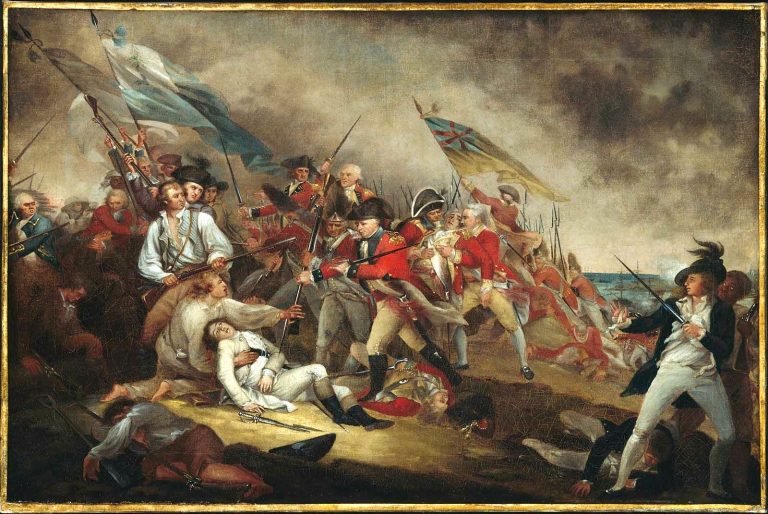
Painting of the death of Joseph Warren at the Battle of Bunker Hill by John Trumbull. Image Source: Wikipedia.
Boston, Massachusetts. We reflect on the Siege of Boston as a defining moment in our nation’s history, one that laid the groundwork for the principles of resilience, leadership, and collective action that we hold dear today. The siege, spanning from April 19, 1775, to March 17, 1776, was not merely a military engagement; it was the crucible in which the resolve and ingenuity of the fledgling American spirit were tested and proven.
The Siege of Boston showcased the strategic brilliance of leaders like George Washington, the innovative spirit of individuals like Henry Knox, and the tactical mastery of Nathaniel Greene. These figures were not just military leaders; they were thought leaders and global citizens whose actions resonated far beyond the battlefield, shaping the very fabric of our nascent nation.
The Strategic Brilliance of George Washington
George Washington’s leadership during the Siege of Boston set a precedent for what it means to be a true leader and a global citizen. As the newly appointed Commander-in-Chief of the Continental Army, Washington faced the daunting task of organizing a diverse group of colonial militias into a coherent fighting force. His arrival in Boston marked a turning point in the siege.
Washington’s strategic foresight was evident in his decision to encircle Boston, effectively cutting off British supply lines and isolating their forces. His emphasis on discipline and rigorous training transformed the Continental Army from a collection of local militias into a unified, effective force. Through Washington’s leadership, we see the qualities of a global citizen—someone who understands the broader implications of their actions and works tirelessly for the greater good.
Washington’s ability to inspire and unify his troops, his strategic acumen in fortifying key positions, and his unwavering commitment to the cause of independence embody the essence of thought leadership. He recognized the significance of the struggle, not just for the American colonies but for the principles of freedom and self-determination that would resonate worldwide.
The Ingenious Artillery Work of Henry Knox
Henry Knox’s contribution to the Siege of Boston is a testament to the power of innovation and determination in the face of seemingly insurmountable challenges. Knox, a former bookseller with a passion for military science, was entrusted with the Herculean task of transporting heavy artillery from Fort Ticonderoga to the strategic heights overlooking Boston.
The successful completion of this mission, known as the “Noble Train of Artillery,” was a turning point in the siege. Knox’s ingenuity in devising a method to move cannons over rough terrain and frozen rivers during the harsh winter months was nothing short of extraordinary. His actions enabled the Continental Army to fortify Dorchester Heights, compelling the British to evacuate Boston without a single shot being fired.
Knox’s story is one of creativity, perseverance, and an unyielding commitment to the cause. His innovative spirit and problem-solving skills are hallmarks of a thought leader. He understood the critical importance of his mission and executed it with precision and determination, exemplifying the qualities of a global citizen dedicated to the greater good.
Nathaniel Greene’s Tactical Mastery
Nathaniel Greene emerged as a key figure during the Siege of Boston, demonstrating the tactical mastery and adaptive thinking necessary for effective leadership. Greene’s ability to analyze the dynamic battlefield environment and respond with innovative strategies made him an invaluable asset to Washington’s command.
Greene’s focus on logistics and supply chain management was crucial in sustaining the Continental Army through the prolonged siege. His understanding of the importance of maintaining a steady flow of resources and his ability to adapt to the changing conditions of war highlighted his strategic thinking and leadership qualities.
Greene’s contributions went beyond mere tactical maneuvers. He embodied the principle of adaptability, recognizing that the evolving nature of the conflict required constant reassessment and innovation. His efforts ensured that the Continental Army remained resilient and capable, underscoring the importance of strategic foresight and flexibility in leadership.
Strategic Brilliance, Innovation: Lessons from the Siege of Boston (July 23, 2014)
#SiegeOfBoston #AmericanRevolution #Leadership #GeorgeWashington #HenryKnox #NathanielGreene #ThoughtLeadership #GlobalCitizenship #HistoricalLessons #Resilience
TAGS: Siege of Boston, American Revolution, George Washington, Henry Knox, Nathaniel Greene, Military Strategy, Leadership, Global Citizenship, Innovation, Tactical Mastery, Historical Events